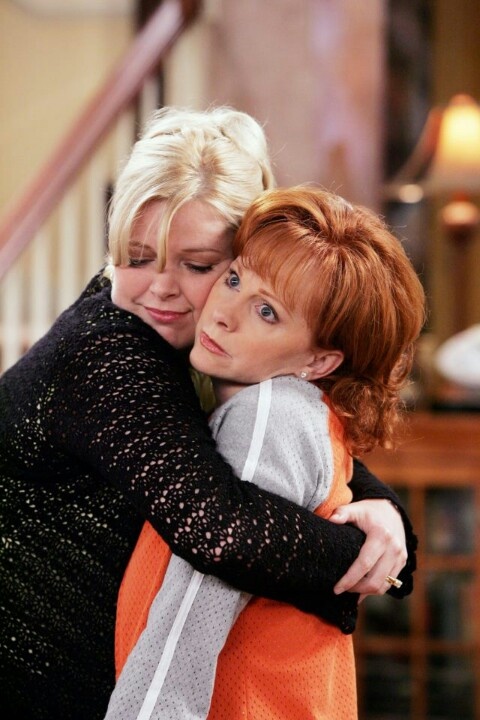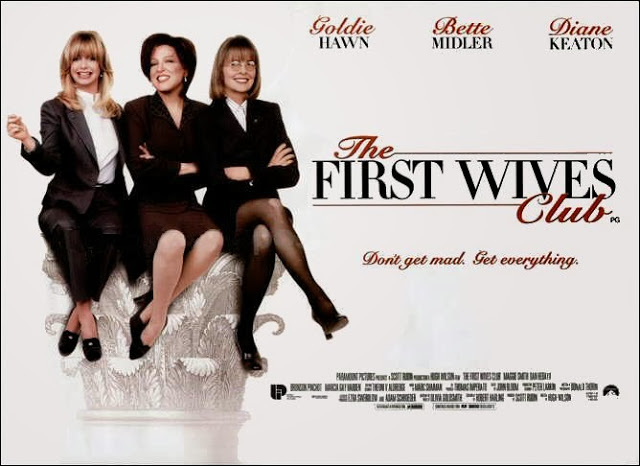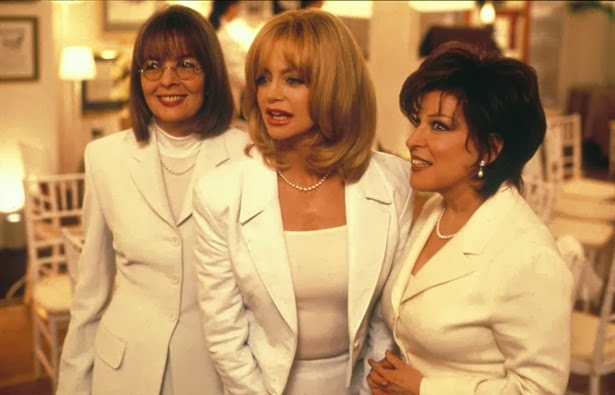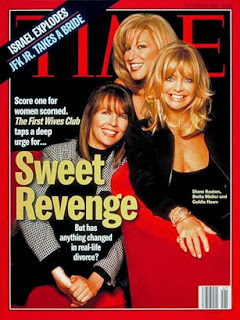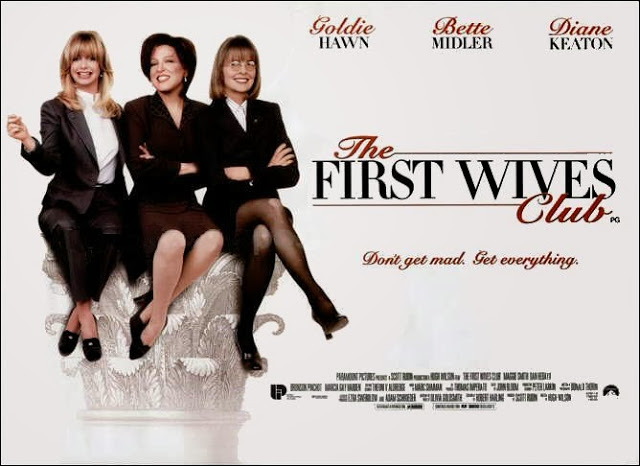Written by Jenny Lapekas.
Like many of us, I’m a child of divorce, and I saw firsthand the lasting effects of infidelity and separation. For years, I’ve turned on Reba because I find it comforting; everything from the stills of the cluttered kitchen to Reba’s adorable southern twang make me feel very tranquil as I clean or type on my laptop. I detect similarities to my own experiences, such as living in close proximity to a parent’s ex or a father who seems to abandon his former life for a newer, shinier one. Reba normalizes these experiences and reminds viewers that every family has its issues.
Reba McEntire herself is a sort of meta presence on the show since she plays herself, in a sense–her character’s name is Reba Hart, she sings the theme song at the beginning of each show (“I’m a Survivor”), and her own values seem to be infused into the show’s script and episodes. The character of Reba also seems to be a direct reflection of Reba the person and musician: genuine, caring, and down-to-earth. We enjoy her interactions with Barbra Jean, whether they’re volatile or pleasant. We like it when they bond and get along (not just for the family but because they are true friends), but we also like it when the two fight or when Reba expresses her annoyance at the tall blonde’s routine antic behavior. Certainly, the show’s plot is unrealistic, but I’d argue that it’s still worthwhile to explore this unique friendship shared by two very different women who discover they indeed have more in common than Brock.

The impossibility of the “new wife” (and former mistress) and ex-wife becoming best friends is at the forefront of this implausibility. Brock is a good father and still “visits” as if he never moved out. Rather than focus on the unbelievable nature of this female friendship, I’d suggest we turn our attention to the healthy post-divorce relationship we see between Reba and Brock. Sure, it’s fantastical and silly, a departure from reality, a pleasant vision of what could be, but also an image of maturity and sophisticated understanding amongst adults–although Kyra usually ends up being the only “adult” when familial conflict arises. The show’s framework suggests not that this type of female friendship is possible (especially involving rivalry and “sharing” a man, in some sense), but that families function even when they don’t function, that hostility and resentment are normal and even healthy components of any family unit.

When Reba’s friend asks her, “How can you even let that woman in your house?!” Reba calmly explains that the kids need to see their father and BJ (go ahead and giggle) is now “part of the package.” However, the relationship between the two Mrs. Harts grows into something more complicated than that: Reba genuinely likes BJ. Contrary to the fear that she may be seen as a powerless doormat, Reba displays incredible strength, patience, and maturity by inevitably becoming BJ’s best friend, despite Reba’s best attempts to prevent the pair’s apparent non-relationship from evolving into anything greater. Viewers may interpret this move as a decision to lay down and endure Brock’s adultery; however, the friendship the women share is an acknowledgment of forgiveness, a radical surrender that frames the world as one that keeps spinning in the face of conflict. There is in fact life after divorce.
BJ represents a very negative stereotype and a cliche: the mistress who ruined a marriage by having an affair with another woman’s husband. However, BJ challenges this stereotype we long to hate so much; she is a larger than life presence, a walking, breathing caricature that we come to adore. As the family celebrates Jake’s birthday party, Kyra eloquently explains that it’s not enough for BJ to plan or attend the party, she is the party. She substitutes the ogre we imagine her to be, the “type of woman” who breaks up a marriage, who sleeps with a married man. BJ humanizes the typecast role assigned to her–she’s charming, she longs to help those around her, and she’s a genuinely good person. Reba explains, “This hasn’t been easy for me, Barbra Jean,” and BJ retorts, “It has just been a freaking picnic for me!” As BJ explains that she’s the “other woman” and is affected by the gossip and phoniness that surround her as well, we’re allowed a glimpse of what it’s like to be blamed for destroying a marriage. Deep down, all BJ wants is to be liked and accepted. In fact, sometimes it seems that she’s willing to forfeit her marriage with Brock in favor of taking on Reba as a permanent partner instead.

When an elderly babysitter proves incapable of managing the kids and the household in Reba’s absence, BJ steps in, cooking delicious meals, organizing the kitchen, and even pouring Reba a glass of wine to help her relax after a long day. Inevitably, Jake hugs BJ and calls her “Mommy,” and Reba is left bitter and horrified. During “girl talk,” Brock wanders in and asks BJ if she’s ever coming home, and BJ informs him that she didn’t make enough food to include him in dinner. Thrilled with BJ’s domestic skills, Reba tells Brock, “I’m starting to see why you left me for her,” and Brock says, “You’re the one with the new wife.” As a result, the house becomes a venue to celebrate this pseudo lesbian relationship, where the needs of the kids are put first, and yes, Brock is still a guest. Although none of the characters realize it, this short-lived partnership is one of great power, demonstrating household productivity and childcare at its zenith.
At times, the trio also seems to mimic a polygamous relationship, such as when Reba tries to repair Brock and BJ’s rocky marriage by counseling them and even offering tips on how to improve their sex life. Much of Reba’s advice is comically common sense, such as instructing Brock to tell BJ that he reversed his vasectomy or telling BJ not to have an emotional affair with the OnStar guy inside the couple’s car. Despite Brock’s past indiscretions, Reba’s priority is the wellness of her family, which includes a successful second marriage for her kids’ father. It’s no mistake the family’s last name is Hart; Reba is clearly the heart of the family, the force around which the others gather, the light BJ finds herself so drawn to.

Even if mine isn’t a popular assessment of BJ’s character, we must admit that we need BJ’s wacky shenanigans to counterbalance Reba’s responsibility, earnestness, and sophistication; there’s no denying that the women’s joint energy creates a dynamic force that carries much of the show. BJ’s character challenges our assumptions about the labels we quickly and often unfairly place on women both real and fictional: home-wrecker, whore, gold-digger, etc. While Reba offers guidance to the naive BJ, the nutty blonde often includes Reba in her misadventures, such as setting up Reba on a blind date or caring for the stubborn redhead after undergoing corrective eye surgery. Regardless of how we feel about the plot of Reba, BJ bursting through the door unannounced and uninvited, along with Brock freely coming and going in a house he no longer lives in draws not an image of turmoil but one of family. BJ’s involvement as a stepmother doesn’t spell dysfunction; rather, the relationships we see on the ABC Family show are nothing if not healthy and honest. In fact, the unlikelihood of the Hart clan’s situation may be exactly why Reba has had such success. My advice: Let the marital stuff go; sit back and enjoy the fact that we’ve been drugged by a witty script, inspiring messages, and a variety of comedic personalities who easily suspend disbelief, all on one lovely show.
________________________________________________
Jenny holds a Master of Arts in English, and she is a part-time instructor at a community college in Pennsylvania. Her areas of scholarship include women’s literature, menstrual literacy, and rape-revenge cinema. She lives with two naughty chihuahuas. You can find her on WordPress and Pinterest.
